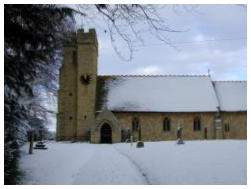




The following is adapted from the leaflet ‘Visitors guide to the historic
church of St James the Great, Aston Abbotts, which is available in the
Church
Aston Abbotts’ well maintained church is still used for regular Sunday
worship, baptisms, funerals and weddings.
We first know of the existence of a church at Aston Abbotts in 1291
when £3 from the tithes was given to the kitchener of St. Albans
Abbey. The Parish Records begin in 1550 and from them we learn, for
example, that the first recorded marriage was on 28th June 1559
between Robert Bishop and Joanne Chalener. We also read that the
parishioners bought a bull for eighteen shillings in 1564 and sold it
three years later for 30 shillings, which sounds like good business.
In the nineteenth century many of the old village cottages were pulled
down and rebuilt. Consideration was also given to the Church, and
almost all that remains of the old church is the Tower. We do not know
quite what ideas the people had for the refurbishment of their ancient
church building, but it became apparent in 1864 that the most practical
option was to completely rebuild the Nave and Chancel on new
foundations. The chosen architect was G. E. Street, a prolific designer
of churches, notably, in Bucks those at Wescott (1867) and
Beachampton (1873) and the work carried out by a local Bierton
builder Mr. Durley at a total cost of £1239.3.11d of which £300 was donated by the
then Lord of the Manor, Lord Overstone.
The church was rededicated by Samuel Wilberforce, Bishop of Oxford, on Whit Tuesday 22nd May 1866.
The rebuilding gave the opportunity for Aston Abbotts' most distinguished resident, Rear Admiral Sir James Clarke Ross, to be commemorated in
the stained glass window above the Altar.
Sir James was England's outstanding polar explorer of the time, who discovered the North magnetic pole in 1831 and also led the expedition
which discovered the Great Ice Barrier in the Antarctic in 1842. He lived in the Abbey House till his death in 1862. His tomb is in the churchyard.
The Church tower is in the perpendicular style, built in the early l6th Century and its roof, formerly covered with lead, is now tiled. It contains a
chiming clock made by Gillett and Co. in 1889 and six bells. The bells are of some interest as numbers 2,3 and 5 were cast in 1652 and inscribed
"Chandler made me". This would have been one of the chandlers who were blacksmiths at Drayton Parslow. The family cast church bells for over a
century in the forge there. Number 4 and 6 are inscribed "Edward Hall made me', - number 4 in 1739 and number 6 in 1740. Number I was given
in 1929 by an American, William Putnam in memory of his ancestor who left Aston Abbotts about 1630. More recently the clock, which replaced an
earlier one, has been refurbished and fitted with an electrical winding mechanism.
St James’ Church drawn by Andy Bystra
In 2005 there was a special service in
St James’ church commemorating Aston
Abbotts’ wartime Czech connection.
This was attended by their excellencies
the Czech and Slovak ambassadors


- Photos
- Aston Abbotts - Winter Pictures
- Aston Abbotts How It Was
- Villagers Pictures - General
- Villagers Pictures - Ken Rhodie
- 630 Club Bean Competition 2011
- Astonbury X 2011 - Page 1
- Astonbury X 2011 - Page 2
- Astonbury X 2011 - Page 3
- Vic Scott Memorial Orchard
- Christmas Lunch 2011
- Peter Kent's Photographs
- Jubilee Picnic 2012
- Village Orchard - One Year On
- Village Orchard - Autum 2012 Planting
- Astonbury 2012
- Videos
- Interviews











